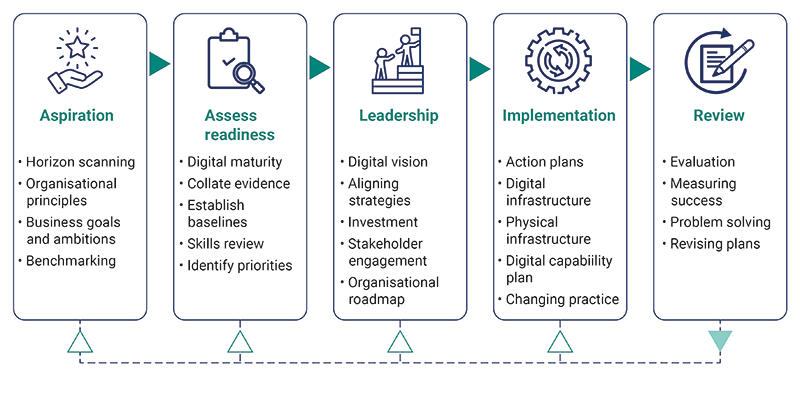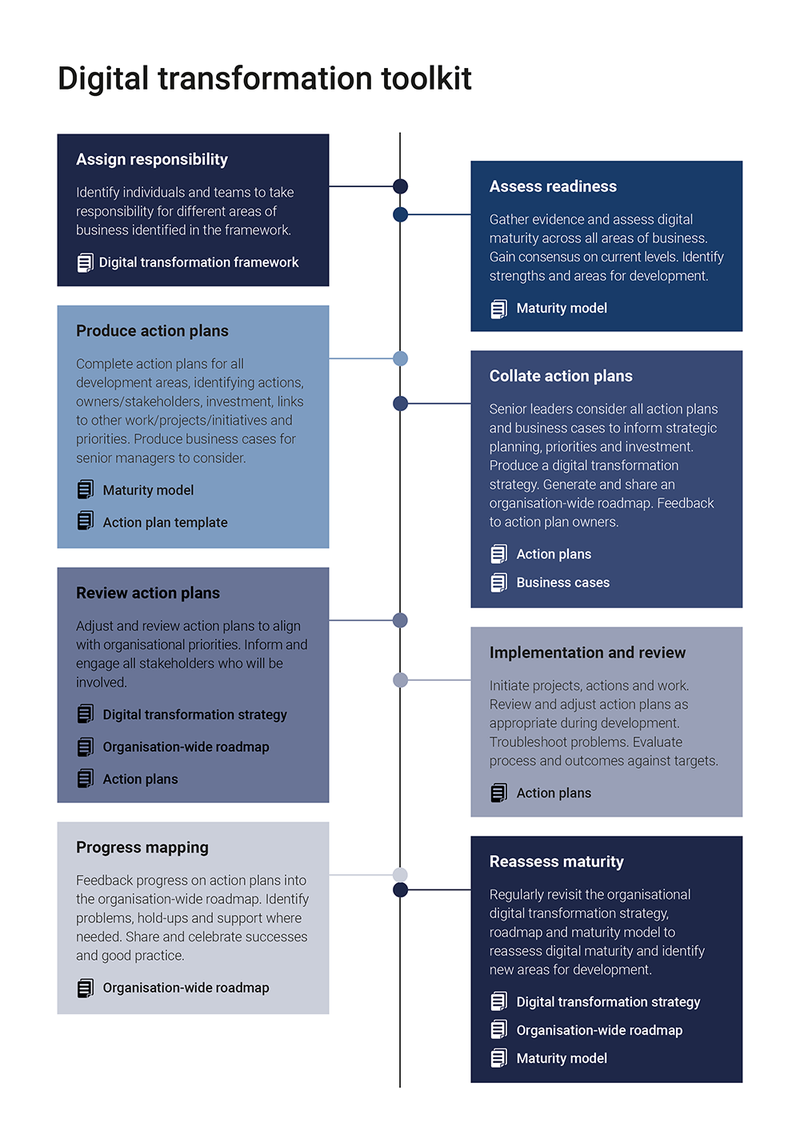Towards digital transformation
Steps towards developing and embedding a strategic approach to digital transformation in your organisation.
“Our digital strategy is one of six enabling sub-strategies designed to support the university in achieving its ambitions. It's not a strategy for an IT department. It's an institutional strategy that touches all members of our community, and which required buy-in throughout the whole community. Digital transformation is an inevitable prerequisite to allow the university to achieve its priorities, its combination of people, process and technology led by digital and a fantastic team.”
Dr Jodie Wetherall, associate director, Office of the Chief Information Officer (CIO), University of Greenwich
There is no single way to achieve digital transformation – it depends on the context of each organisation. Digital transformation activities and approaches should be founded on organisational goals and values, should reflect business ambitions and be implemented strategically. However, there are some common elements to the process that need to be addressed, and some of these will already be well established.

Alternative text for digital transformation steps diagram
A diagram illustrating the steps to digital transformation.
- Aspiration: horizon scanning, organisational principles, business goals and ambitions, benchmarking
- Assess readiness: digital maturity, collate evidence, establish baselines, skills review, identify priorities
- Leadership: digital vision, aligning strategies, investment, stakeholder engagement, organisational roadmap
- Implementation: action plans, digital infrastructure, physical infrastructure, digital capability plan, changing practice
- Review: evaluation, measuring success, problem solving, revising plans
A diagram illustrating the steps to digital transformation.
- Aspiration: horizon scanning, organisational principles, business goals and ambitions, benchmarking
- Assess readiness: digital maturity, collate evidence, establish baselines, skills review, identify priorities
- Leadership: digital vision, aligning strategies, investment, stakeholder engagement, organisational roadmap
- Implementation: action plans, digital infrastructure, physical infrastructure, digital capability plan, changing practice
- Review: evaluation, measuring success, problem solving, revising plans
Questions to ask
“I often subscribe to the view that you shouldn’t have a digital strategy any more than you would have an electricity strategy. What matters is how digital supports the pillars of the university strategy. But sometimes it is useful to have a digital strategy, and a member of the top team with digital responsibility, so that there is something for digital to coalesce around.”
Professor Susannah Quinsee, vice president (digital and student experience), City, University of London
Adopting a strategic approach to digital transformation can stimulate a review of existing processes, structures and management practices. It enables organisations to ask questions about their current state and to assess readiness, investment plans, governance and vision for the future. You can work through the questions on this page or try our short 10 minute survey which allows you to record your answers and print them as a pdf to share and encourage conversations with colleagues:
Aspiration
Vision and strategy
- What is our vision for digital transformation and how does it align with our overall strategic goals (eg environmental sustainability, equity, diversity and inclusion (EDI), internationalisation, local and regional impact)?
- How will digital transformation help us to improve our services, operations and stakeholder experiences?
- What is our attitude to digital: is our main priority operational resilience and business continuity; enhancing the organisation's mission, or major changes to our business model?
- How can digital improve learning, teaching and assessment?
- How can digital drive our research forward?
- How can digital enhance the unique selling point and reputation of our institution?
- How do we benchmark ourselves across the sector?
Assess readiness
Readiness and current state
- What is our baseline in terms of digital maturity, and what are our biggest gaps?
- How digitally capable are our stakeholders (leaders, governors, staff, students, partners)?
- What evidence do we have about the ways that different staff (teaching, research, professional services, etc.) experience the digital environment?
Leadership
Planning and prioritisation
- What is our roadmap for digital transformation, and how do we plan to prioritise different initiatives?
- How will we balance the need for operational efficiency with the investment in digital transformation?
Governance and leadership
- Is there sufficient digital awareness among the executive team and the board of governors for them to make informed decisions in strategic digital areas, to inspire and model good practice?
- What structures or mechanisms will we put in place to govern the digital transformation process?
- Which internal processes and governance structures need to change so that we can track the performance of our digital strategy and respond to new opportunities in an agile way?
Stakeholder engagement
- How will we engage with different stakeholders during the transformation process?
- What communication strategy will we employ to manage change effectively?
Investment and resources
- What kind of financial investment are we prepared to make in digital transformation?
- Do we have the necessary resources (human, technological, time) to implement our digital transformation strategy?
Implementation
Risk management
- What potential risks could we face when taking digital initiatives forward, and how do we plan to mitigate them?
- How do we plan to manage the cyber security risks associated with increased digitalisation?
Changing practice
- What do we need to do to improve the digital competencies of all stakeholders?
- How do we work with stakeholders as partners in change?
Technology and infrastructure
- Do we have the necessary secure and reliable technology infrastructure to support our digital transformation?
- How do we balance investment and effort to refresh, consolidate and/or integrate existing/legacy systems and services – and also develop new ones as appropriate?
- How can we ensure that physical and virtual infrastructure integrate efficiently and effectively to deliver strategic objectives?
Data management and security
- How will we manage the increased volume and variety of data that comes with digitalisation?
- How do we improve the flow of data between systems to support informed decision making?
- How do we plan to ensure data privacy and protection in the new digital environment?
Review
Performance measurement and review
- How will we measure the success of our digital transformation initiatives and have we embedded ongoing review mechanisms?
- What key performance indicators (KPIs) will we use to monitor progress and adjust our strategy as necessary?
The process of asking and reflecting on these questions is an important start for any organisation when creating an effective digital transformation strategy that aligns with its vision, leverages its strengths and addresses its challenges.
“Digital transformation is at the heart of the University of Leeds’ strategy. There is complete senior buy-in, and commitment to resource, empower, engage and support colleagues and teams to harness technological progress delivering locally anchored global impact.”
Professor Arunangsu Chatterjee, dean of digital transformation, University of Leeds
Steps towards digital transformation
You can use this toolkit in a variety of ways to support digital transformation, depending on your organisation's stage on the pathway. The toolkit consists of a framework which offers a structure for digital transformation, a maturity model to help assess digital maturity, a roadmap template and a range of other guidance and support materials. You may find it helpful to work through the framework, or prefer to go directly to the maturity model. The roadmap/action plan template can be used alongside either of these documents as the same structure is used for all the materials.
The framework structure allows individuals and teams to quickly see where their areas of responsibility fall and encourages them to focus on specific areas of the framework or maturity model. The scale and size of the framework and maturity model reflect the complexities of HE provider activities. The framework and the maturity model both highlight some aspects that need consideration across all sections such as organisational values around equity, EDI, environmental sustainability, ethics, quality etc.
The framework and maturity model can be approached in sections by different individuals and teams, and the action plan and roadmap template allow a common approach to recording engagement with the maturity model and producing action plans. The template offers a coherent approach that means action plans can be shared/amalgamated (if appropriate) and allows senior leaders to have an immediate understanding of plans, priorities and progress. Leaders can easily see the priorities of different teams and there is a mechanism to adjust these as appropriate when considered at a strategic organisational level. You can use the template to produce an organisation-wide roadmap.
This is a suggested process for organisations to adopt but you can use the various elements of the toolkit and stages of the process to suit your own needs, contexts and approaches.

Download this overview document to see more detail about how to use the toolkit in your organisation:
Download the maturity model for digital transformation: overview (docx)
Download the maturity model for digital transformation: overview (pdf)
Next section: Using the framework for digital transformation
How the framework offers a structured holistic approach and common language for digital transformation across the sector.
Next section: Using the framework for digital transformation
This toolkit is made available under Creative Commons License (CC BY-NC-SA).